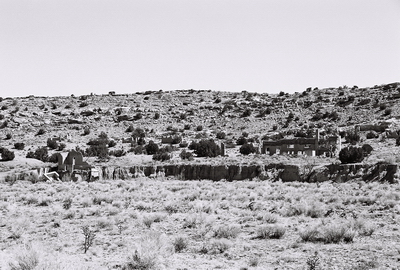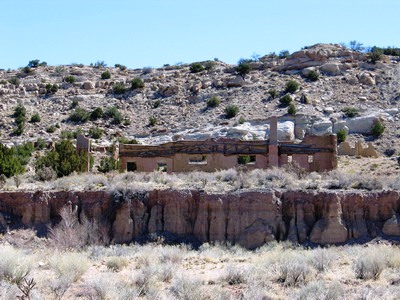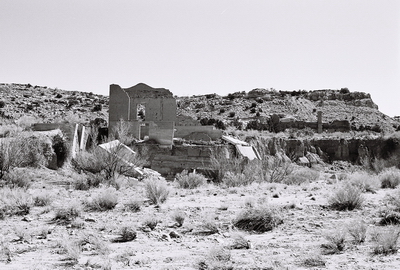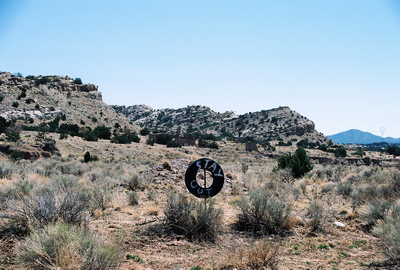skip to main |
skip to sidebar

At this point, there’s not much anyone can say about the ghost town of Coyote, New Mexico, and there's even less to see. Like HAGAN, its neighbor just to the southeast, it’s located on land owned by the Diamond Tail Ranch. However, nearly a century after being abandoned, the town has been reduced to just a few piles of adobe behind a fence that it wouldn’t be real wise to try to climb over. But, Coyote is a bona fide ghost town, and so I’ll include it here.
Coyote is about three miles from HAGAN and its fate was very much tied to that town, which had been founded about two years earlier, in 1902. Workers from the Sloan Mine first established Coyote and then waited for the railroad to come through and connect the town with Hagan and other points of commerce. But, as I mentioned in the previous post, two efforts to get tracks to Hagan failed before a third was finally successful in 1924. The tracks eventually came within a half mile of Coyote but by then it didn’t matter because Coyote was already dead and gone. Now all that remains are a few foundations.
The only real historical source I found for Coyote was Philip Varney’s ghost town guide. Even Varney couldn't provide much information about Coyote and, whatever might have unfolded there during the town's brief existence, it seems it will never be known by the likes of us.

The next few posts will be similar to this one: short and sweet. There might be a bit of prose, too. But I’ve got quite a backlog of old New Mexican treasures and I’m accumulating more rapidly. The next post will be about one particular building along old Route 66. Stay tuned.
The top photo shows the remains of Coyote, but the truck was photographed literally in the middle of nowhere, Chihuahuan Desert, Socorro County, New Mexico. I dare you to try and find it.

East of I-25, beyond the San Felipe Casino north of Albuquerque and down a dirt county road heading towards Madrid, lay the ruins of Hagan, New Mexico. Established in 1902, Hagan was yet another New Mexican town brought to life by coal, taking its name from mining investor William Hagan. Coal deposits had been discovered along the Una de Gato (Cat’s Claw) Arroyo and, by 1905, about 60 miners were living in Hagan, adjacent to the base of operations.

Hagan had to wait a long time for the railroad, the life’s blood of any mining town. Hauling coal by wagon was so expensive that the mines were shut down by 1910. After a line was finally run to the Atchison, Topeka & Santa Fe in 1924, following a couple failed attempts, the town’s population grew to about 500. Soon Hagan had running water, electricity, and toilets and some large structures were built, including Hagan Mercantile (shown above), then the largest adobe building in New Mexico. Cattle ranching and brick-making also became important ways of making a living in Hagan. However, the railroad had been running less than six years when the coal seam started to thin out around 1930. The town died quickly. A few folks stuck around until the very early 1940's, but the post office was already gone by 1931.

Not much remains of Hagan. There are a couple crumbling buildings, a few foundations, and a slowly capsizing railroad way station (pictured above). However, Hagan’s location is very picturesque and its apparent (if not actual) remoteness makes for some excellent atmosphere. But if you visit, don’t go beyond the overlook beside the road. The Hagan property is owned by the sprawling Diamond Tail Ranch and posted as private. As none of our party was able to read the day of our trip, we crossed the arroyo and walked right into what was once the old town. But we got to spend only a few moments taking photos before a representative of NEW MEXICO JEEP TOURS arrived and asked us to leave. He was cordial enough (and, of course, he didn’t need to be) but made it clear that there was no way we were setting foot in Hagan without booking a jeep tour. The jeep tours look very interesting, actually, so perhaps NM Jeep Tours would like to provide me with a promotional discount. I’d certainly like to see a bit more of Hagan and check out the nearby petroglyphs, too.
The Hagan property is owned by the sprawling Diamond Tail Ranch and posted as private. As none of our party was able to read the day of our trip, we crossed the arroyo and walked right into what was once the old town. But we got to spend only a few moments taking photos before a representative of NEW MEXICO JEEP TOURS arrived and asked us to leave. He was cordial enough (and, of course, he didn’t need to be) but made it clear that there was no way we were setting foot in Hagan without booking a jeep tour. The jeep tours look very interesting, actually, so perhaps NM Jeep Tours would like to provide me with a promotional discount. I’d certainly like to see a bit more of Hagan and check out the nearby petroglyphs, too.

Hagan has almost completely sunk beneath the sands of time. There is very little information available on the town’s history and much of what is out there is repetitious or, in some cases, probably wrong. So, my synopsis is based on my trusty copy of New Mexico's Best Ghost Towns: A Practical Guide by Philip Varney (1981, Northland Press) and an excellent post (including better photos than I was able to get) by the Torrance County Archaeological Society.
The next City of Dust post will be on Hagan’s ghost town neighbor, Coyote. Also, a stay at the St. James Hotel in Cimarron, New Mexico has been booked. In addition to being one of America’s most haunted hotels, the St. James is rich with history and bullet holes. A post on it will be forthcoming.





 The Hagan property is owned by the sprawling Diamond Tail Ranch and posted as private. As none of our party was able to read the day of our trip, we crossed the arroyo and walked right into what was once the old town. But we got to spend only a few moments taking photos before a representative of
The Hagan property is owned by the sprawling Diamond Tail Ranch and posted as private. As none of our party was able to read the day of our trip, we crossed the arroyo and walked right into what was once the old town. But we got to spend only a few moments taking photos before a representative of 